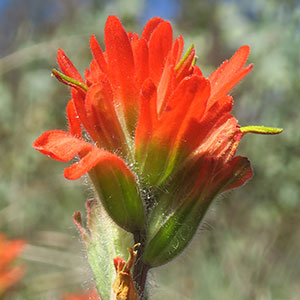Castilleja brevilobata
Castilleja lineariloba
short-lobed paintbrush
pale owl-clover, thin-lobed owl's clover
solitary or few, erect or ascending, unbranched, sometimes branched, hairs spreading, short, medium, and long, soft, short and medium ones short stipitate-glandular.
solitary or few, erect, unbranched or branched, hairs spreading, short to long, ± stiff, mixed with short stipitate-glandular ones.
green or ± yellow, lanceolate, elliptic, or oblong to narrowly ovate, 1–2(–2.5) cm, not fleshy, margins plane or wavy, involute, (0–)3–5(–7)-lobed, apex rounded to acute;
lobes ascending to erect, linear to lanceolate, apex rounded to acute.
green, linear to narrowly lanceolate or narrowly oblong, 2–5.7 cm, not fleshy, margins plane, flat, 3–7(–9)-lobed, apex acuminate to acute;
lobes spreading to ascending, linear to narrowly oblong, apex acuminate.
3–20 × 2–3.5 cm;
bracts proximally greenish to dull brown, distally red, orange-red, or scarlet, sometimes orange or yellow, broadly lanceolate or oblong, (0–)3–5-lobed;
lobes ascending, broadly to narrowly lanceolate, short, arising above mid length, apex acute, obtuse, or rounded.
2–14 × 1–4 cm;
bracts greenish throughout, or proximally greenish, distally white, cream, pale pink, or pale purple on apices, linear-lanceolate, 5–7(–9)-lobed, sometimes with secondary lobes;
lobes ascending to spreading, linear to narrowly oblanceolate, long, arising all along leaf axis, apex acute to obtuse.
straight, 15–24(–26) mm;
tube 12–16 mm;
beak exserted, abaxial lip equal to calyx;
beak adaxially green or ± yellow-green, 7–10 mm, puberulent, stipitate-glandular;
abaxial lip deep green, reduced, rounded, 1–2 mm, 10–25% as long as beak;
teeth incurved to erect, light green, 0.5–1 mm.
straight or slightly curved, 12–25 mm;
tube 9–14 mm, expanded distally;
abaxial lip sometimes slightly exserted, never hidden by slender calyx lobes, beak exserted;
beak straight, adaxially white or lilac pink, 3–5.5 mm, inconspicuously puberulent;
abaxial lip proximally white, distally yellow, with purple or red-brown spots, conspicuous, pouches 3, inflated, 4–6 mm, 4–5 mm wide, 2 mm deep, longer than deep, 1.5–4 mm, 90% as long as beak;
teeth erect, white, usually with purple spot at base, 0.5–1 mm.
green or whitish with green veins, lobes colored as bract lobes or paler, 14–30 mm;
abaxial and adaxial clefts 5.5–8.5 mm, 30–40% of calyx length, deeper than laterals, lateral 1.5–4 mm, 20–25% of calyx length;
lobes oblong to narrowly triangular, apex obtuse to rounded.
colored as bracts, 15–25 mm; all 4 clefts subequal, 7–11 mm, 50–67% of calyx length;
lobes linear, apices often slightly expanded, apex obtuse to acute.
glabrous.
= 24.
= 20.
Castilleja brevilobata
Castilleja lineariloba
Castilleja brevilobata is endemic to dry serpentine openings in the Siskiyou Mountains of southwestern Oregon and adjacent California. Although sometimes treated as part of C. applegatei or C. hispida, its morphology does not suggest a close connection with either. This species occasionally hybridizes with C. pruinosa in Del Norte County, California.
(Discussion copyrighted by Flora of North America; reprinted with permission.)
Castilleja lineariloba is endemic to the western slope of the Sierra Nevada. Its chromosome number is 2n = 20, an apparent aneuploid reduction and documented by numerous counts. This diploid number is shared only with two very distantly related annual species endemic to central Mexico, C. gracilis Bentham and C. tenuifolia M. Martens & Galeotti.
(Discussion copyrighted by Flora of North America; reprinted with permission.)
- Local floras:
CA
- Local Web sites:
CalFlora,
CalPhotos
WildflowerSearch
iNaturalist (observations)
- LBJ Wildflower Center
- SEINet
- Plants of the World Online
- Encyclopedia of Life
- Wikipedia
- Google Image Search


